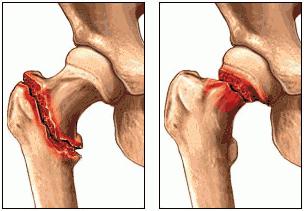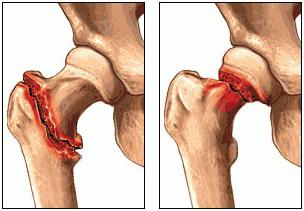Fractures of the neck of the thigh: their diagnosis and treatment

Fracture of cervix: symptoms
1) Pain is the first and most important symptom of thistype of injury. Concentrating in the inguinal region, when moving, it only intensifies. Most often, a person who has received such a fracture is confined to bed because of severe pain. However, there are cases when painful feelings did not cause serious discomfort to the victim for several days or even weeks. Such fractures are fraught with transformation from closed damage to the open, it is also possible to traumatize the vessels and tissues surrounding the broken bone.
2) External rotation is the position of the foot when it is slightly turned outward.
3) Shortening of the limb by 2-4 centimeters as a result of contraction of the gluteus muscles, pulling the leg close to the pelvis.
4) Limited movement of the foot up and down.

Fractures of the neck of the thigh: treatment
As already described above, hip fracturesthey themselves rarely grow together very rarely, which means that they almost always require surgical intervention and subsequent rehabilitation. Patients with extra-capsular injuries are usually prescribed osteosynthesis. This is an operation to fix a broken bone with a metal pin.
Intracapsular fractures require prosthetics- replacement of the hip joint. Patients who underwent such a fracture of the neck of the hip, even though walking with crutches, can walk a couple of days after the radical intervention.
No matter what kind of operation wasis carried out, in a short time the patient is appointed specially selected for him therapeutic physical training and physiotherapy, which is designed to help him to restore the functions of the damaged limb as soon as possible.

Fractures of the neck of the thigh: complications
Here is just a short list of problems that can arise in a patient with a fracture of the neck of the hip that is chained to the bed:
• pressure sores;
Atony of the intestine;
• congestive pneumonia;
• rotation of the foot;
• problems of a psychological nature.





